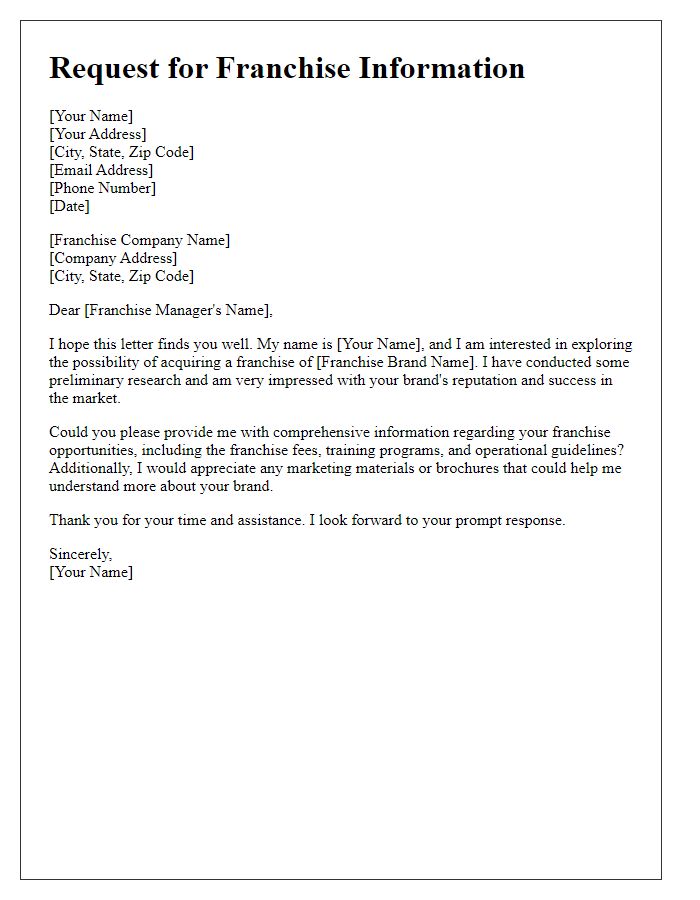Are you considering expanding your business through franchising? The franchise model offers a fantastic opportunity to scale your brand while leveraging the passion and investment of franchisees. In this article, you'll discover key elements for crafting a compelling franchising proposal that attracts potential partners. So, let's dive in and explore how to present your vision effectively!

Clear introduction and purpose
An effective franchising proposal request begins with a clear introduction and purpose statement to capture interest and outline intentions. For example, "XYZ Corporation, a leading brand in the fast food industry with over 500 locations worldwide, seeks to expand its franchise network. The objective of this proposal is to articulate our interest in establishing a franchise partnership, providing detailed insights on the benefits, operational strategies, and potential market opportunities for aspiring franchisees in targeted regions. Our proposal aims to outline the necessary steps for collaboration while emphasizing the support and resources available to ensure franchisee success.
Detailed business concept and unique selling proposition
A well-defined business concept and unique selling proposition (USP) are crucial in the realm of franchising, especially for emerging brands aiming to capture market share. The business concept outlines the operational framework and strategic direction, including target demographics, service or product offerings, and market positioning. An example of a successful concept is the interactive dining experience provided by theme restaurants, such as the Rainforest Cafe, which incorporates both a unique atmosphere and engaging customer experiences. The USP distinguishes the franchise from competitors, highlighting aspects such as proprietary recipes, exclusive services, or an innovative shopping model--a prime example being the product customization offered by companies like SubZero Ice Cream, where each order is made-to-order using liquid nitrogen. Collaborating with a franchisor entails thorough market analysis and strategic branding efforts that concretely demonstrate value to potential franchisees, driving consistent growth and profitability across locations.
Market analysis and target demographics
The franchising proposal for fast-casual dining establishments focuses on the market analysis of urban locations in the United States, particularly targeting cities with populations exceeding 500,000. This demographic analysis highlights young professionals aged 25 to 40, a group that increasingly favors quick, healthy meal options and values sustainability. Current trends show that 60% of this demographic dines out at least three times a week, and they are more inclined towards brands that offer unique culinary experiences and transparent sourcing practices. Additionally, competition analysis reveals a substantial gap in the market for diverse plant-based menu offerings, with only a limited number of established brands catering to this demand, indicating a promising opportunity for growth.
Franchise support and training overview
The franchise support provides comprehensive training programs crucial for franchisees, enabling them to understand operational standards and best practices essential for business success. Initial training usually lasts two weeks at the franchise headquarters, and it covers areas like marketing strategies, customer service techniques, and financial management. Ongoing support includes quarterly webinars, access to a dedicated franchise support hotline, and regional meetings that foster a community among franchisees. Additionally, resource materials such as operation manuals and marketing templates are made available, ensuring uniformity across different locations and enhancing brand consistency. This robust support system is designed to equip franchisees with the tools needed to navigate challenges and maximize profitability.
Financial projections and investment details
A franchising proposal request requires detailed financial projections and investment specifics to attract potential franchisees. Key components include initial investment estimates, covering franchise fees, equipment costs, and leasehold improvements, typically ranging from $50,000 to $250,000 depending on the industry. Ongoing royalty fees should be clearly delineated, often based on a percentage of gross sales, commonly between 5% to 10%. Break-even analysis offers insight into projected earnings, usually expected within the first three years of operation. Additionally, a detailed forecast of profit margins, with anticipated annual revenue growth rates around 10% to 20%, can be beneficial. Highlighting key metrics such as average unit volume (AUV), which for fast-food franchises often exceeds $1 million annually, can further enhance the proposal's appeal. Providing comprehensive data on market trends and competitive landscape in specific locations, such as urban areas experiencing 5% annual growth, adds valuable context for prospective investors.













Comments